
The same economic rules that operate in a simple economic society also apply to a more complicated one....
Able's initial willingness to create capital through his own personal sacrifice benefited the other islanders. As a result of his prudent lending program, the islanders built many hand nets, and then capitalized on the increased productivity to fund much more efficient fishcatching machines. In addition to allowing a better diet, more flattering attire, and easier transport, the increased productivity gave rise to leisure time and a burgeoning surfing scene.
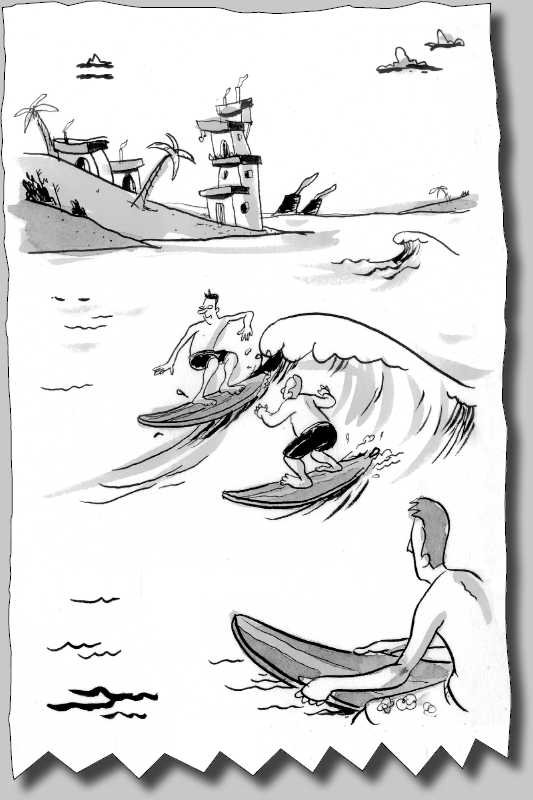
Tales of this unprecedented luxury soon spread to other islands, where fishing was still done by hand and no one had time to surf. In search of a better life, immigrants soon arrived.
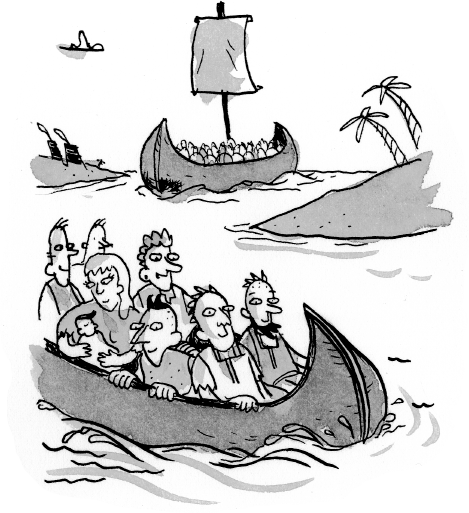
The greater productivity of the island meant that it could support a greater population, which in turn led to greater economic diversity. Some new immigrants went to work servicing the mega fish catchers, while others borrowed the extra fish to clear the land for farming—at last a balanced diet! Others took out loans to go into other trades.
The diversified island economy soon gave rise to hut builders, canoe builders, wagon builders, you name it.
Society had become so good at producing food and tools that some people didn't need to produce anything physical to survive. As a result, a service sector was born.
Looking to improve on the delectability of the raw fish, some islanders developed specialized systems of fish preparation, often involving spices and fire. The skills of these chefs became so highly prized that the more prosperous fishermen and hut builders would pay them fish in exchange for their culinary skills.
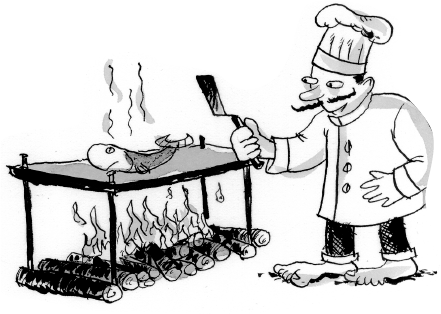
Other service jobs developed soon after.
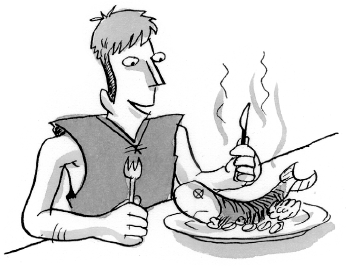
The allure and social benefits of surfing became so widely prized that Charlie's descendants founded a surfing school.
As the society grew and more trades and services were offered, a medium of exchange was needed so that the hut builder, chef, or surfing instructor could be paid.
Up till now, the island had functioned on a barter system, where one person traded one good or service for another. But this process was cumbersome and inefficient. A spear maker may want a chef, but a chef may not want a spear. Even if their desires did converge, how many cooked meals would a spear be worth, anyway?
To replace this system of haphazard deal making, the island needed something that could be traded for anything and that was accepted by everybody. In other words, they needed money.
Since everyone on this island ate fish, it was decided that fish would serve as money.
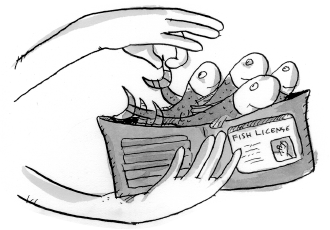
In short order, all wages and prices were quoted in terms of fish. And since subsistence was still imagined at one fish per day, one fish had a value to which everyone could relate. The island's price structure therefore was related to the real (or intrinsic) value of fish.
An economy in which workers can specialize in a specific trade or service is always better than one where everyone does the same thing. Specialization increases production, which in turn raises living standards.
Let's say that it took the average islander five days to make a canoe. If it is assumed that every islander could catch two fish per day (with a net), then each person would have to forgo 10 fish of income in order to build a canoe. However, one islander named Duffy was a little better at cutting, hauling, and chopping wood and could make a canoe in just four days.
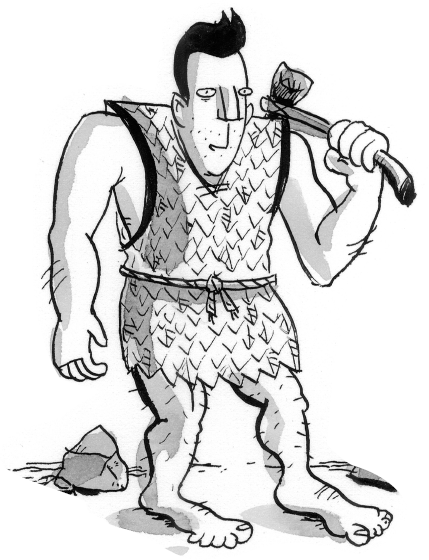
Rather than fishing like everybody else, Duffy decided to just make canoes. As he only had to defer eight fish in income to build a canoe, he made a profit by charging nine fish for one of his models. He raised his income through specialization.
Given Duffy's advantages, other islanders were wise to buy from him had. Left to themselves, they would have had to give up 10 fish in income. By paying nine to a specialist, they saved one fish.
But suppose nine fish represented a fairly steep price...after all, who has that many fish just lying around? Perhaps at those prices only the wealthiest islanders could afford a new canoe. Those who didn't have that level of accrued savings would just have to keep swimming until they had saved enough to pull the trigger.
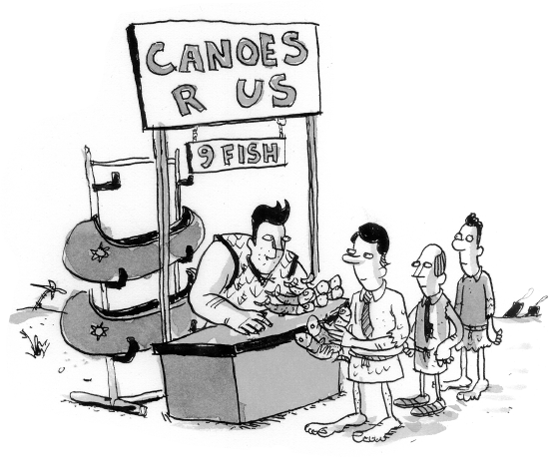
But after years of cutting and shaping his logs with rocks and sharp shells, Duffy used his accumulated savings to build specialized canoe-making tools. Like Able many generations before, he underconsumed in order to generate a capital good (tools).
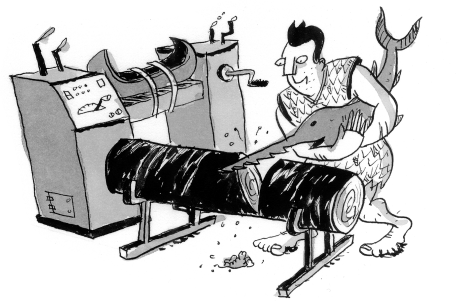
Because of his better equipment, Duffy cut his building time down to two days. With this increased efficiency, he now had to charge four fish instead of eight fish per canoe to break even. By lowering his price to six fish (from nine) he was more profitable on each canoe he sold (two fish per canoe instead of one), what's more, he was able to crank out twice as many units.
This increased productivity benefited not only Duffy, but all the islanders. More could afford a canoe priced at just six fish, so his customer base increased.

As a result of this improved efficiency—made possible by savings, innovation, and investment—the price for canoes came down and the benefits of canoe ownership became available to a wider pool of buyers. What was once a luxury for the rich became common for everyone.
As the society became more complex, more and more islanders decide to work for other people by trading their labor for wages.
The value of labor is always multiplied by the use of capital. The better the capital, the more valuable the labor. For instance, you can dig a bigger hole with a bulldozer than with a shovel, even if you work just as hard with both. Thus, it's best to work with the best capital available.
In a free society all the residents decide for themselves whose capital to use to magnify the value of their labor. Putting aside those who metaphorically choose to fish without a net (perhaps for artistic reasons), each worker is free to:
Underconsume to build a net.
Take out a business loan to buy a net.
Work for someone who already has a net.
As the first option requires underconsumption, and the second option involves risk, most workers choose the third option. If they do, they are paid wages.
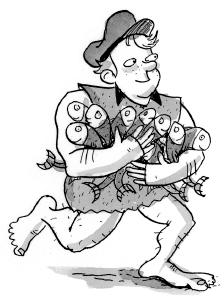
For instance, Finnigan, a new arrival on the island, was a very strong man. His talents were wasted as a fisherman, so he decides to specialize in fish transport. Relying solely on his brawn, Finnigan was able to deliver 100 fish per day from the beach to people's huts. At a 2 percent freight charge, Finnigan earned two fish per day working for himself.
However, having previously taken out a business loan to build a fish cart, Murray's Cart Company was stiff competition. Using his own cart, Murray could deliver 300 fish per day, even though he was not nearly as strong as Finnigan. Based on his high level of productivity, he charged only a 1 percent rate, thereby earning three fish per day. So because of his capital he was able to charge a lower rate and still earn more than Finnigan.
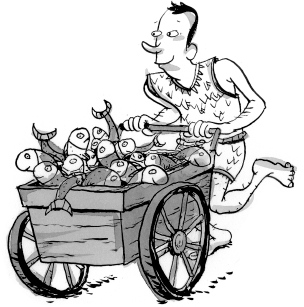
Without his own capital, Finnigan was in a pickle.
Assuming that the burlier guy could deliver 400 fish a day with a cart, Murray sensed an opportunity. As Finnigan could generate four fish per day in income with the cart (using the 1 percent delivery rate), Murray offered him three fish per day as an employee. Murray could keep the fourth fish as profit.
If Finnigan took the job, he would increase his productivity, lower his delivery rate, and earn more than he could by himself.
With the one-fish-per-day profit, Murray could stop delivering the fish himself, and focus on building more carts and expanding his business by hiring more delivery people. Meanwhile, proliferation of carts will bring down freight costs for all islanders.
Hopefully, at some point down the road, Finnigan could save up his income and build his own cart to compete against his former boss. In order to prevent this from happening, Murray would have to pay Finnigan more than he could have gotten on his own, and enough to discourage him from leaving the company.
But Murray's potential for profit is the sole motivation for all of this. He doesn't intend to help out Finnigan, but he does so inadvertently. The result is a better-paid worker and lower costs for all.
There is no greater propaganda victory in economics today than the complete vilification of deflation (and the relative acceptance of inflation). As far as economists and politicians are concerned, deflation, which is defined as the overall decline of prices over time, is the economic equivalent of the bubonic plague. At the slightest whiff of deflation, governments will typically enact policies to push prices back up.
But what's wrong with falling prices? Habituated as we have become to steadily rising prices, it would shock just about everyone to know that prices in the United States fell steadily for almost 150 years...from the late 1700s all the way to 1913! But during that time we experienced some of the fastest economic growth in the history of the planet. This was made possible for the precise reasons described in this chapter: increased efficiency. When combined with a stable supply of money (as existed in the United States until the establishment of the Federal Reserve), efficiency will push prices down.
The vastly increased productivity of the industrial revolution made it possible for working-class people to afford all kinds of goods, like upholstered furniture, tailored clothing, plumbing, and wheeled transportation, that were previously available only to the rich. Deflation meant that $100 saved in 1850 could buy many more goods and services in 1880. Why is this not a good thing? While modern grandparents habitually point out how much cheaper stuff was when they were kids, their own grandparents likely told stories to them about how much more expensive things were in their youth.
Yet despite the obvious benefits of lower prices, we still fear deflation. We are told that if prices were to fall, people would stop buying, companies would stop spending, workers would lose their jobs, and we would all return to the economic dark ages.
But we all see time and time again how falling prices do not deter particular industries. In the early twentieth century, Henry Ford made a fortune, and his workers became the best paid in the industry, by steadily bringing down the price of cars. More recently the computer industry has made bundles of money despite the fact that its products constantly experience significant price deflation. Yet despite plunging prices the computer revolution continues unabated. As a result of this efficiency in design and manufacture, millions and millions of people each year spend less and less to experience the marvels of digitization.
Despite this, most people assume that deflation is okay if it's confined to just one industry. Why would that be?
Modern economists mistakenly assume that spending drives growth, and that when deflation is present, people tend to defer purchases (to allow prices to fall); and when they do spend, the diminished price makes less of an economic impact. This is absurd.
As we've said before, it's not the spending that means anything. It's the production that counts!
People do not need to be persuaded to spend. Given that human demand is essentially endless, if people don't want something there is likely a good reason. Either the product is no good or the consumer simply cannot afford to buy it. Either way, the act of deferring a purchase, or saving instead of spending, is made for rational reasons and tends to benefit the economy as a whole.
In fact, if consumers are not spending, the best way to spur demand is to allow prices to fall to more affordable levels. Sam Walton made billions with this simple concept.
When Plasma TV's first came out, few Americans bought them. Although just about everyone wanted one, not many could come up with the $10,000 needed to bring one home. However, as prices fell more people took the plunge and profits rose as higher volumes made up for lower prices.
It takes a gifted economist to argue that consumers are hurt by falling prices. Would lower food and energy prices really be so bad? Would more affordable health care or education require government to protect us from the danger?
Despite all the exculpatory evidence, deflation remains economic enemy number one. This is because inflation (the opposite of deflation), is every politician's best friend. More about this later.
